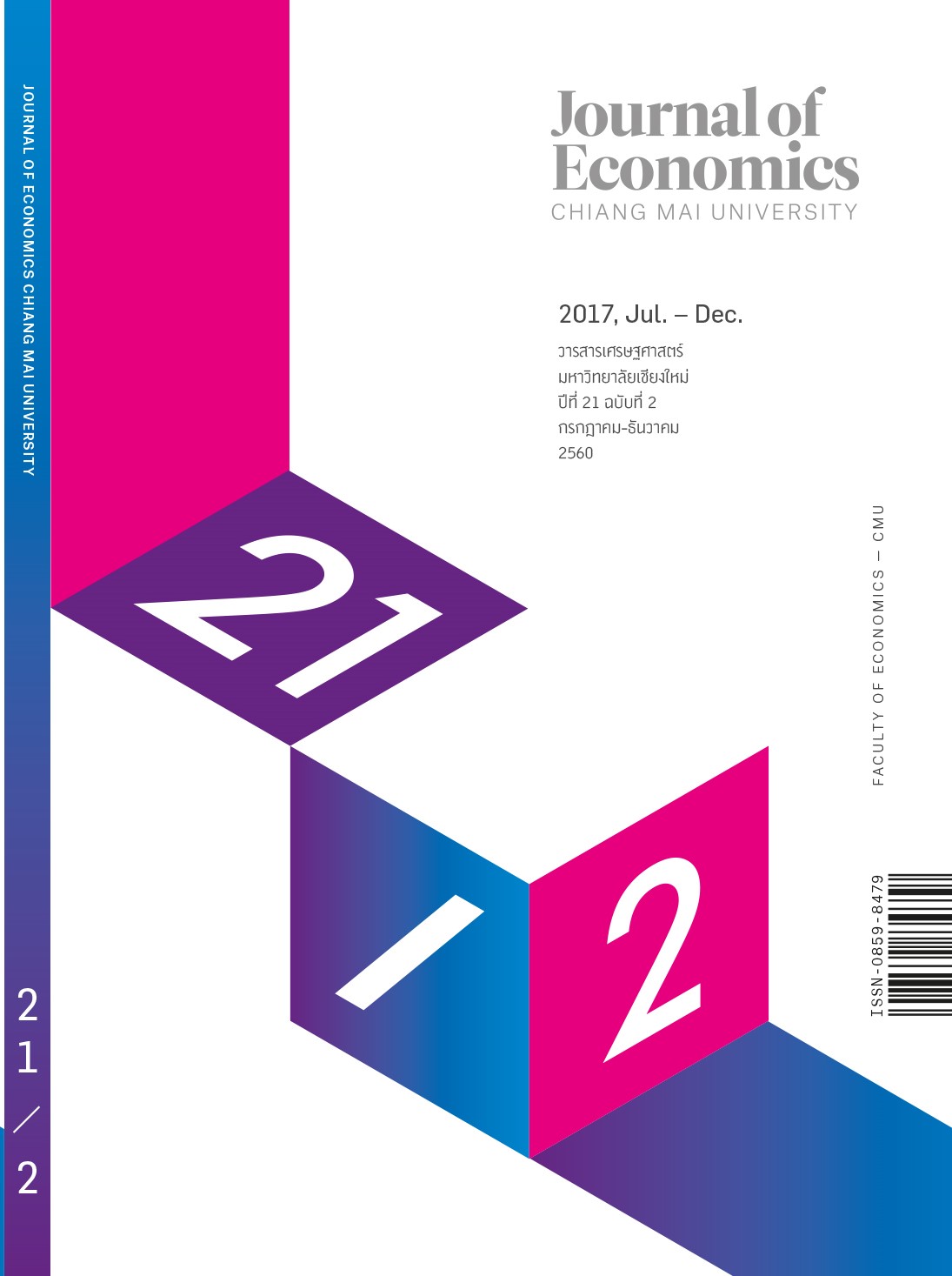การประเมินและเปรียบเทียบผลการดำเนินงาน กองทุนรวมหุ้นระยะยาวของประเทศไทย
Evaluation and Comparison of the Performance of Long Term Equity Fund in Thailand
Keywords:
long term equity fund, Sharpe measure, Treynor measure, simulation, กองทุนรวมหุ้นระยะยาว, มาตรวัดของชาร์ป, มาตรวัดของเทรเนอร์, การจำลองชุดข้อมูลAbstract
Abstract
Thailand has encouraged and promoted household savings through various forms such as saving in financial institutions and investing in fixed income securities, equity securities and mutual funds. Government promotes investment in long term equity fund (LTF) by allowing tax deduction. Therefore, long term equity funds are in consideration among Thai investors.
This research evaluated and compared the performance of nine long term equity funds in Thailand that had the highest net asset value as of December 30, 2016 and operated from December 30, 2011 to December 30, 2016. The rate of returns, risk, Sharpe measure, Treynor measure, and simulation are employed.
This results showed that the top three funds that had the high rate of returns were Bualuang LTF, Bualuang LTF 75/25, and Aberdeen LTF, while K equity dividend, K 20 select LTF, K equity LTF, and K equity dividend LTF were the top three funds that having the high risk. The results of the comparison the performance using the Sharpe and Treynor measures showed that Bualuang LTF, Bualuang LTF 75/25, Aberdeen LTF, K 20 select LTF, and Krungsri dividend stock LTF had the higher rate of return per one unit of risk compare to the stock exchange of Thailand index. Moreover, two simulations were performed with two distributions. One was logistic distribution that tested by the Anderson-Darling statistics and another was normal distribution. This method revealed that Bualuang LTF perform the best, follow by Bualuang LTF 75/25, K equity LTF, and Aberdeen LTF.
Keyword: long term equity fund, Sharpe measure, Treynor measure, simulation
JEL Classification Codes: G10, G11, G19
บทคัดย่อ
ประเทศไทยได้มีการสนับสนุน ส่งเสริมให้ภาคครัวเรือนในประเทศมีการออมในหลายรูปแบบ เช่น การฝากเงินกับสถาบันการเงิน การลงทุนในตราสารหนี้ การลงทุนในตราสารทุน รวมถึงการลงทุนผ่านกองทุนรวมต่างๆ โดยการลงทุนผ่านกองทุนรวมนั้น รัฐบาลได้สนับสนุนโดยสามารถนำเงินลงทุนในกองทุนรวมหุ้นระยะยาวมาลดหย่อนภาษีได้ ดังนั้นกองทุนรวมหุ้นระยะยาวจึงได้รับความสนใจจากนักลงทุน
การวิจัยนี้จึงได้ทำการประเมิน และเปรียบเทียบผลการดำเนินงานกองทุนรวมหุ้นระยะยาวของประเทศไทยจำนวน 9 กองทุนที่มีมูลค่าทรัพย์สินสุทธิสูงสุด ณ วันที่ 30 ธันวาคม พ.ศ. 2559 และดำเนินงานในระหว่างวันที่ 30 ธันวาคม พ.ศ. 2554 ถึงวันที่ 30 ธันวาคม พ.ศ. 2559 รวมระยะเวลา 5 ปี โดยการหาอัตราผลตอบแทน ความเสี่ยง การใช้มาตรวัดของชาร์ป มาตรวัดของเทรเนอร์ และการจำลองชุดข้อมูลมาใช้ในการวิจัย
ผลการวิจัยพบว่า กองทุนเปิดบัวหลวงหุ้นระยะยาว กองทุนเปิดบัวหลวงหุ้นระยะยาว 75/25 และกองทุนเปิดอเบอร์ดีนหุ้นระยะยาว ให้อัตราผลตอบแทนสูงสุดสามลำดับแรก ขณะที่กองทุนเปิดเค 20 ซีเล็คท์หุ้นระยะยาวปันผล กองทุนเปิดเคหุ้นระยะยาว และกองทุนเปิดเคหุ้นระยะยาวปันผลมีความเสี่ยงสูงสุดสามลำดับแรก เมื่อพิจารณาจากมาตรวัดของชาร์ป และมาตรวัดของเทรเนอร์พบว่า กองทุนเปิดบัวหลวงหุ้นระยะยาว กองทุนเปิดบัวหลวงหุ้นระยะยาว 75/25 กองทุนเปิดอเบอร์ดีนหุ้นระยะยาว กองทุนเปิดเค 20 ซีเล็คท์หุ้นระยะยาวปันผล และกองทุนเปิดกรุงศรีหุ้นระยะยาวปันผลให้อัตราผลตอบแทนต่อหนึ่งหน่วยของความเสี่ยงมากกว่าดัชนีราคาตลาดหลักทรัพย์ ส่วนการจำลองชุดข้อมูล หากกำหนดให้อัตราผลตอบแทนของกองทุนนั้นมีการแจกแจงแบบโลจิสติกซึ่งทดสอบโดยค่าสถิติ Anderson-Darling และสมมติการแจกแจงแบบปกติ พบว่า กองทุนเปิดบัวหลวงหุ้นระยะยาวมีผลการดำเนินงานหรือมีประสิทธิภาพมากกว่ากองทุนอื่นๆ ส่วนกองทุนเปิดบัวหลวงหุ้นระยะยาว 75/25 กองทุนเปิดเคหุ้นระยะยาว และกองทุนเปิดอเบอร์ดีนหุ้นระยะยาวมีผลการดำเนินงานรองลงมาและใกล้เคียงกัน
คำสำคัญ: กองทุนรวมหุ้นระยะยาว มาตรวัดของชาร์ป มาตรวัดของเทรเนอร์ การจำลองชุดข้อมูล
JEL Classification Codes: G10, G11, G19
References
Lintner, J. (1965). The Valuation of Risk Assets and the Selection of Risky Investments in Stock Portfolio and Capital Budgets. Review of economics and statistic, 47(1), 13-37.
Markowitz, H. (1952). Portfolio Selection. Journal of Finance, 7(1), 77-91.
Mossin, J. (1966). Equilibrium in a Capital Asset Market. Econometrica, 34(4), 768-783.
Sangkaew, J. (2002). Investment. Bangkok, Thammasat Printinig House. (in Thai).
Sharpe, W. F. (1964). Capital Asset Prices: A Theory of Market Equilibrium under Conditions of Risk. Journal of finance, 19(3), 425-442.
Sharpe, W. F. (1966). Mutual Fund Performance. Journal of Business, 39, 119-138.
Tassanaburisut, K. (2009). The Measurement of Risk and Return of Fixed Income Mutual Fund. Bangkok: Graduate School, Srinakharinwirot University. (in Thai).
Tianchairoj, A. (2009). Comparison of Returns in Gold Bullion, Gold Mutual Fund, and Oil Fund. Bangkok: Grduate School, Thammasat University. (in Thai)
Treynor, J. L. (1965). How to Rate Management of Investment Funds. Harvard Business Review, 43, 63-70.
Wongsak, P. (2006). Risk and Returns Analysis of Mutual Funds Investment in Foreign Countries. Chiang Mai: Grduate School, Chiang Mai University. (in Thai).
Downloads
Published
Issue
Section
License
All opinions and contents in the CMJE are the responsibility of the author(s). Chiang Mai University Journal of Economics reserves the copyright for all published materials. Papers may not be reproduced in any form without the written permission from Chiang Mai University Journal of Economics.
ข้อคิดเห็นที่ปรากฏและแสดงในเนื้อหาบทความต่างๆในวารสารเศรษฐศาสตร์มหาวิทยาลัยเชียงใหม่ ถือเป็นความเห็นและความรับผิดชอบโดยตรงของผู้เขียนบทความนั้นๆ มิใช่เป็นความเห็นและความรับผิดชอบใดๆของวารสารเศรษฐศาสตร์ มหาวิทยาลัยเชียงใหม่
บทความ เนื้อหา และข้อมูล ฯลฯ ในวารสารเศรษฐศาสตร์มหาวิทยาลัยเชียงใหม่ ถือเป็นลิขสิทธิ์เฉพาะของคณะเศรษฐศาสตร์มหาวิทยาลัยเชียงใหม่ หากบุคคลหรือหน่วยงานใดต้องการนำทั้งหมดหรือส่วนหนึ่งส่วนใดไปเผยแพร่ต่อหรือเพื่อกระทำการใดๆ จะต้องได้รับอนุญาตเป็นลายลักษณ์อักษร จากวารสารเศรษฐศาสตร์ มหาวิทยาลัยเชียงใหม่






